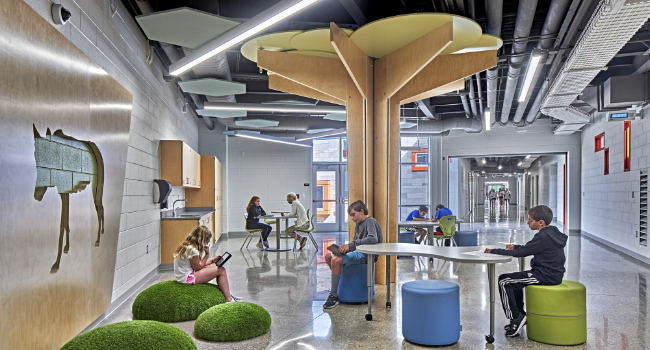
Making Safety and Security Intrinsic to School Design
- By Ron Boezwinkle, Jason Russell
- May 22, 2024
Public anxieties about school safety are escalating across the country. According to a 2023 Gallup report, 44% of parents fear for their child’s physical safety at school, a 10 percentage-point increase since 2019. Unfortunately, these fears are likely to increase if the incidence of school tragedies continues to mount. As a result, school leaders are now charged with two non-negotiable responsibilities. The first, as always, is to ensure kids have what they need to learn, grow, and thrive. Sadly, their second responsibility is to keep the children in their care safe from threats and physical danger.
This is why many school leaders are taking the issues around secure school design far more seriously today than they might have in the past. Our own work — we’re a secure environments expert and an educational architect — has thrown a clear spotlight on this new focus. Here are six important points to consider at the pivot point of school design and security.
Security starts with assessment. Any plan to integrate stronger security measures into a school should begin with a thorough site assessment. This entails having a security consultant visit the school to evaluate any vulnerabilities it may have in physical security and emergency preparedness. The site assessment should provide a 360-degree examination of the school, its practical functions, and its surroundings. It should include a review of current safety policies and procedures, and onsite interviews with key staff and leadership. This thorough examination of internal and external design features will identify any technical and physical gaps in security.
Security occurs in layers. Experts agree that the best physical design practices to impede active threats include delaying access to the most occupied portions of the building. Incorporating layers of security includes creating a secure entrance, then limiting access to classroom wings or pods, followed by securing the individual learning spaces. Following these steps is the most effective approach to increasing safety and security in school facilities.
Avoid focusing solely on active violent threats. While active-shooter events are a very real threat, they are still a rare occurrence. Instead, it is best to use a multi-hazard approach to guide safety and security enhancements. Consider other threats such as fire and medical emergencies and leverage alert systems, technology, door locks and identification, and staff training to enhance responses.
Security enhancements do not need to be expensive. Effective design measures will customize security improvements to address a school’s biggest risks. For example, an elementary school may focus more efforts on the main entrance and exterior doors to address external threats, while a high school may need to focus on behavioral threat assessments, as risks tend to be internal.
Effective plans and training are essential components for safety and security. People often feel safer in a physical space that has been updated and secured. Safety planning requires us to look at all layers involved, including technology, equipment, processes, procedures, and training. For example, if a school decides to revise its main entrance, associated security protocols must be updated. This includes training staff, students, and visitors to ensure that the improvements provide the intended safety enhancements.
Both threats and educational needs will change over time. If a school is designed based only on today’s threats, the building will be left with spaces that won’t work in the future. Instead, designing schools for the next generation of learners should be done through the lens of educating the whole child. Being flexible with design elements, and keeping building occupants top of mind always, will ensure that school safety and security is supported in future uses and needs.
Providing staff with appropriate training and plans for any safety risk — whether that’s a medical emergency, a natural disaster, or an active violence threat — is paramount to success. This should include reaching out to local fire and law-enforcement officials or third-party security consultants to assist in training. Their expert perspectives will provide additional insights and will also allow them to better understand the facility before an emergency hits.
Beyond physical safety, schools should also be designed to address student’s psychological well-being. For many students, school is a place where they feel most secure, most connected, and most cared for. It can offer an escape from circumstances where they're not sure when their next meal is coming or if their basic needs will be met. Promoting social-emotional learning through design empowers kids to identify their emotions and develop interpersonal relationship skills with self-advocacy strategies that promote positive conflict resolution. When students are equipped with the skills to recognize their mental health needs, they are more proactive in seeking out resources and can better identify at-risk behaviors in their peers.
Finally, keep in mind that the earlier in the design process these measures are taken, the better. It is easier to embed safety into a building or to make any needed adjustments before any work has begun. Combining security elements specific to each facility with educational best practices will result in safer schools designed to support students and staff.
This article originally appeared in the May / June 2024 issue of Security Today.